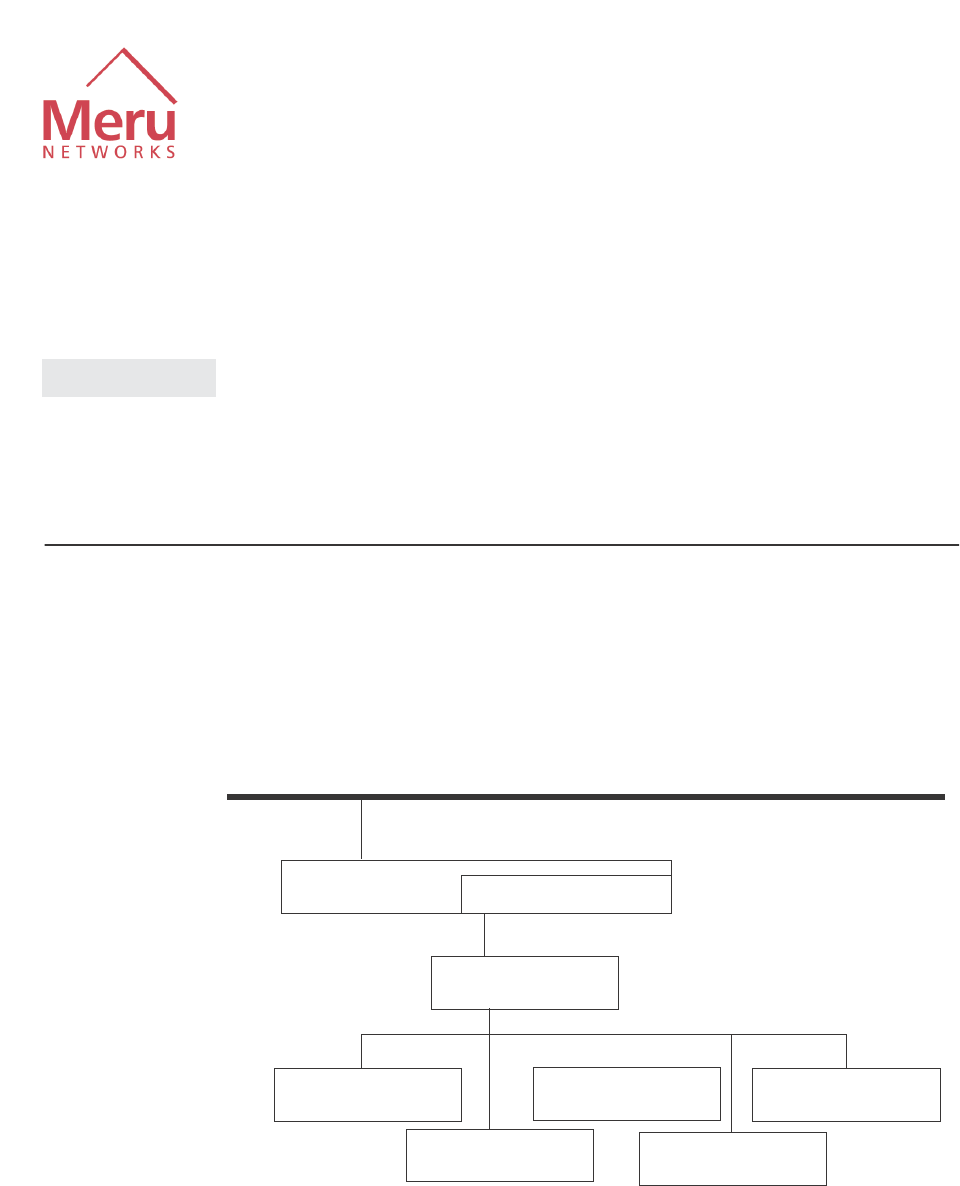Meru Networks AP100 802.11b Access Point User Manual CLIref BK
Meru Networks Inc. 802.11b Access Point CLIref BK
Contents
- 1. professional installation
- 2. users manual 2
professional installation

PRELIMINARY
Meru Wireless Networking
Product
1.0
Beta
Command-Line Interface Reference
July 2003
Document Number: xxxxxx

PRELIMINARY
Revision History
Information in this document is provided in connection with Meru
®
products. No license, express or implied, by estoppel or otherwise, to any intellectual
property rights is granted by this document. Except as provided in Meru’s Terms and Conditions of Sale for such products, Meru assumes no liability
whatsoever, and Meru disclaims any express or implied warranty, relating to sale and/or use of Meru products including liability or warranties relating
to fitness for a particular purpose, merchantability, or infringement of any patent, copyright or other intellectual property right. Meru products are not
intended for use in medical, life saving, or life sustaining applications.
Meru may make changes to specifications and product descriptions at any time, without notice.
Designers must not rely on the absence or characteristics of any features or instructions marked “reserved” or “undefined.” Meru reserves these for
future definition and shall have no responsibility whatsoever for conflicts or incompatibilities arising from future changes to them.
The product may contain design defects or errors known as errata which may cause the product to deviate from published specifications. Current
characterized errata are available on request.
Meru Networks, Inc. might have patents or pending patent applications covering subject matter in this document. The furnishing of this document does
not give any license to these patents.
This document as well as the described in it are furnished under license and may only be used or copied in accordance with the terms of the license.
The information in this document is furnished for informational use only, is subject to change without notice, and should not be construed as a
commitment by Meru Networks, Inc.. Meru Networks, Inc. assumes no responsibility or liability for any errors or inaccuracies that may appear in this
document or any software that may be provided in association with this document. Except as permitted by such license, no part of this document may
be reproduced, stored in a retrieval system, or transmitted in any form or by any means without the express written consent of Meru Networks, Inc..
Contact your local Meru sales office or your distributor to obtain the latest specifications and before placing your product order.
Copies of documents which have an ordering number and are referenced in this document, or other Meru literature may be obtained by calling
or by visiting Meru’s website at http://www.merunetworks.com
Copyright © Meru Networks, Inc., 2003. All rights reserved.
*Other names and brands may be claimed as the property of others.
This product includes software developed by parties other than Meru.
See the back page of this document for a list of copyrights and license
agreements.
Revision Date Revision Description
July 2003 0.1 1.0
Beta
release.

PRELIMINARY
Contents
iii
Revision 0.1, July 2003
Contents
About This Document . . . . . . . . . . . . . . . . . . vii
Audience . . . . . . . . . . . . . . . . . . . . . . . . . . . . . . . vii
In This Guide. . . . . . . . . . . . . . . . . . . . . . . . . . . . . . vii
Other Sources of Information . . . . . . . . . . . . . . . . . . . . . . . viii
Typographic Conventions . . . . . . . . . . . . . . . . . . . . . . . . viii
Syntax Notation . . . . . . . . . . . . . . . . . . . . . . . . . . . ix
Contacting Meru . . . . . . . . . . . . . . . . . . . . . . . . . . . . ix
Web and Internet Sites . . . . . . . . . . . . . . . . . . . . . . . . ix
Customer Support Technicians . . . . . . . . . . . . . . . . . . . . . x
Chapter 1
Key Concepts . . . . . . . . . . . . . . . . . . . . . . . 1
Network Layout . . . . . . . . . . . . . . . . . . . . . . . . . . . . .1
Node Identification . . . . . . . . . . . . . . . . . . . . . . . . . . . .2
Serial Numbers and Node Numbers . . . . . . . . . . . . . . . . . . . 2
Using the Controller Console and the CLI . . . . . . . . . . . . . . . . . . 2
Chapter 2
CLI Command Reference . . . . . . . . . . . . . . . . . 1
Overview . . . . . . . . . . . . . . . . . . . . . . . . . . . . . . . . 2
Alarms Commands . . . . . . . . . . . . . . . . . . . . . . . . . . . . 3
alarms . . . . . . . . . . . . . . . . . . . . . . . . . . . . . . . . 3
asc: Subcontroller Commands . . . . . . . . . . . . . . . . . . . . . . . 5
asc all . . . . . . . . . . . . . . . . . . . . . . . . . . . . . . . . 5
asc get . . . . . . . . . . . . . . . . . . . . . . . . . . . . . . . . 5
asc ids . . . . . . . . . . . . . . . . . . . . . . . . . . . . . . . . 6
asc set . . . . . . . . . . . . . . . . . . . . . . . . . . . . . . . . 7
PRELIMINARY
iv
Contents
Revision 0.1, July 2003
ats: Access Point Commands . . . . . . . . . . . . . . . . . . . . . . . . 8
ats all. . . . . . . . . . . . . . . . . . . . . . . . . . . . . . . . . 8
ats get . . . . . . . . . . . . . . . . . . . . . . . . . . . . . . . . 8
ats ids . . . . . . . . . . . . . . . . . . . . . . . . . . . . . . . . 9
ats images. . . . . . . . . . . . . . . . . . . . . . . . . . . . . . 10
ats mappings . . . . . . . . . . . . . . . . . . . . . . . . . . . . 10
ats scripts . . . . . . . . . . . . . . . . . . . . . . . . . . . . . . 10
ats set . . . . . . . . . . . . . . . . . . . . . . . . . . . . . . . 10
ats upgrade . . . . . . . . . . . . . . . . . . . . . . . . . . . . . 11
auth: RADIUS Authentication Commands . . . . . . . . . . . . . . . . 12
auth all . . . . . . . . . . . . . . . . . . . . . . . . . . . . . . . 12
auth del. . . . . . . . . . . . . . . . . . . . . . . . . . . . . . . 12
auth get. . . . . . . . . . . . . . . . . . . . . . . . . . . . . . . 12
auth new . . . . . . . . . . . . . . . . . . . . . . . . . . . . . . 13
auth set . . . . . . . . . . . . . . . . . . . . . . . . . . . . . . . 13
authstats get. . . . . . . . . . . . . . . . . . . . . . . . . . . . . 14
Channel BSSID Commands . . . . . . . . . . . . . . . . . . . . . . . 15
channel all . . . . . . . . . . . . . . . . . . . . . . . . . . . . . 15
channel get . . . . . . . . . . . . . . . . . . . . . . . . . . . . . 15
channel ids . . . . . . . . . . . . . . . . . . . . . . . . . . . . . 16
channel set . . . . . . . . . . . . . . . . . . . . . . . . . . . . . 16
connect or remote: Remote Connection Commands. . . . . . . . . . . . . 17
{connect | remote} . . . . . . . . . . . . . . . . . . . . . . . . . . 17
connect asc . . . . . . . . . . . . . . . . . . . . . . . . . . . . . 17
connect ats . . . . . . . . . . . . . . . . . . . . . . . . . . . . . 17
Console Commands . . . . . . . . . . . . . . . . . . . . . . . . . . 18
console get . . . . . . . . . . . . . . . . . . . . . . . . . . . . . 18
console paging. . . . . . . . . . . . . . . . . . . . . . . . . . . . 19
console set . . . . . . . . . . . . . . . . . . . . . . . . . . . . . 19
db: Configuration Backup Commands . . . . . . . . . . . . . . . . . . 20
db backup . . . . . . . . . . . . . . . . . . . . . . . . . . . . . 20
db delete . . . . . . . . . . . . . . . . . . . . . . . . . . . . . . 20
db list . . . . . . . . . . . . . . . . . . . . . . . . . . . . . . . 20
db restore . . . . . . . . . . . . . . . . . . . . . . . . . . . . . . 21
Help Commands . . . . . . . . . . . . . . . . . . . . . . . . . . . . 22
help . . . . . . . . . . . . . . . . . . . . . . . . . . . . . . . . 22
History Commands . . . . . . . . . . . . . . . . . . . . . . . . . . . 23
history . . . . . . . . . . . . . . . . . . . . . . . . . . . . . . . 23
if...stats: Interface Statistics Commands . . . . . . . . . . . . . . . . . . 24
if80211stats all . . . . . . . . . . . . . . . . . . . . . . . . . . . . 24
if80211stats get . . . . . . . . . . . . . . . . . . . . . . . . . . . 24
if80211stats ids . . . . . . . . . . . . . . . . . . . . . . . . . . . 25
ifstats. . . . . . . . . . . . . . . . . . . . . . . . . . . . . . . . 25
ifstats all . . . . . . . . . . . . . . . . . . . . . . . . . . . . . . 26
ifstats get . . . . . . . . . . . . . . . . . . . . . . . . . . . . . . 26
ifstats ids . . . . . . . . . . . . . . . . . . . . . . . . . . . . . . 27
PRELIMINARY
Contents
v
Revision 0.1, July 2003
if: Interface Commands . . . . . . . . . . . . . . . . . . . . . . . . . 29
{interface | ifc} . . . . . . . . . . . . . . . . . . . . . . . . . . . 29
interface all . . . . . . . . . . . . . . . . . . . . . . . . . . . . . 29
interface get. . . . . . . . . . . . . . . . . . . . . . . . . . . . . 29
interface ids . . . . . . . . . . . . . . . . . . . . . . . . . . . . . 30
interface set . . . . . . . . . . . . . . . . . . . . . . . . . . . . . 31
qoS or codec: Quality of Service Commands. . . . . . . . . . . . . . . . 32
qoscodec all . . . . . . . . . . . . . . . . . . . . . . . . . . . . . 32
qoscodec del . . . . . . . . . . . . . . . . . . . . . . . . . . . . 32
qoscodec get . . . . . . . . . . . . . . . . . . . . . . . . . . . . 32
qoscodec ids . . . . . . . . . . . . . . . . . . . . . . . . . . . . 33
qoscodec new . . . . . . . . . . . . . . . . . . . . . . . . . . . . 34
qosrule or ruleQoS: Rule Commands . . . . . . . . . . . . . . . . . . . 36
qosrule all . . . . . . . . . . . . . . . . . . . . . . . . . . . . . 36
qosrule del . . . . . . . . . . . . . . . . . . . . . . . . . . . . . 36
qosrule get . . . . . . . . . . . . . . . . . . . . . . . . . . . . . 36
qosrule ids . . . . . . . . . . . . . . . . . . . . . . . . . . . . . 38
qosrule new. . . . . . . . . . . . . . . . . . . . . . . . . . . . . 38
qosstats. . . . . . . . . . . . . . . . . . . . . . . . . . . . . . . 39
qosvars . . . . . . . . . . . . . . . . . . . . . . . . . . . . . . . 40
qosvars get . . . . . . . . . . . . . . . . . . . . . . . . . . . . . 40
qosvars set . . . . . . . . . . . . . . . . . . . . . . . . . . . . . 40
Quit Commands . . . . . . . . . . . . . . . . . . . . . . . . . . . . 42
quit . . . . . . . . . . . . . . . . . . . . . . . . . . . . . . . . 42
Reboot (or restart) Commands . . . . . . . . . . . . . . . . . . . . . . 43
{reboot | restart}. . . . . . . . . . . . . . . . . . . . . . . . . . . 43
reboot all . . . . . . . . . . . . . . . . . . . . . . . . . . . . . . 43
reboot asc. . . . . . . . . . . . . . . . . . . . . . . . . . . . . . 43
reboot ats . . . . . . . . . . . . . . . . . . . . . . . . . . . . . . 43
reboot wnc . . . . . . . . . . . . . . . . . . . . . . . . . . . . . 44
security: RADIUS Security Commands . . . . . . . . . . . . . . . . . . 45
{security | sec} . . . . . . . . . . . . . . . . . . . . . . . . . . . 45
security get . . . . . . . . . . . . . . . . . . . . . . . . . . . . . 45
security set . . . . . . . . . . . . . . . . . . . . . . . . . . . . . 46
SNMP Commands . . . . . . . . . . . . . . . . . . . . . . . . . . . 47
snmp del . . . . . . . . . . . . . . . . . . . . . . . . . . . . . . 47
snmp get . . . . . . . . . . . . . . . . . . . . . . . . . . . . . . 47
snmp new . . . . . . . . . . . . . . . . . . . . . . . . . . . . . 48
snmp set . . . . . . . . . . . . . . . . . . . . . . . . . . . . . . 48
Station Commands . . . . . . . . . . . . . . . . . . . . . . . . . . . 50
station all . . . . . . . . . . . . . . . . . . . . . . . . . . . . . . 50
station del . . . . . . . . . . . . . . . . . . . . . . . . . . . . . 50
station get . . . . . . . . . . . . . . . . . . . . . . . . . . . . . 50
station set. . . . . . . . . . . . . . . . . . . . . . . . . . . . . . 51
{stationstats | stastats} . . . . . . . . . . . . . . . . . . . . . . . . 51
stationstats all . . . . . . . . . . . . . . . . . . . . . . . . . . . . 52
topo: Network Topology Commands . . . . . . . . . . . . . . . . . . . 53
PRELIMINARY
vi
Contents
Revision 0.1, July 2003
{topoascats | ascats} . . . . . . . . . . . . . . . . . . . . . . . . . 53
topoascats all . . . . . . . . . . . . . . . . . . . . . . . . . . . . 53
topoats . . . . . . . . . . . . . . . . . . . . . . . . . . . . . . . 53
topoats all. . . . . . . . . . . . . . . . . . . . . . . . . . . . . . 54
{topoatsats | atsats} . . . . . . . . . . . . . . . . . . . . . . . . . 54
topoatsats all . . . . . . . . . . . . . . . . . . . . . . . . . . . . 54
{topostaats | staats} . . . . . . . . . . . . . . . . . . . . . . . . . 55
topostaats all . . . . . . . . . . . . . . . . . . . . . . . . . . . . 55
topostation all . . . . . . . . . . . . . . . . . . . . . . . . . . . . 55
Watchdog Commands. . . . . . . . . . . . . . . . . . . . . . . . . . 57
{watchdog | wd}. . . . . . . . . . . . . . . . . . . . . . . . . . . 57
watchdog get . . . . . . . . . . . . . . . . . . . . . . . . . . . . 57
watchdog set . . . . . . . . . . . . . . . . . . . . . . . . . . . . 57
watchdog get . . . . . . . . . . . . . . . . . . . . . . . . . . . . 58
watchdog set . . . . . . . . . . . . . . . . . . . . . . . . . . . . 58
wirelessif or wif: Wireless Interface Commands . . . . . . . . . . . . . . 59
wirelessif all. . . . . . . . . . . . . . . . . . . . . . . . . . . . . 59
wirelessif get . . . . . . . . . . . . . . . . . . . . . . . . . . . . 59
wirelessif ids . . . . . . . . . . . . . . . . . . . . . . . . . . . . 61
wirelessif set . . . . . . . . . . . . . . . . . . . . . . . . . . . . 61
wnc: Controller Commands . . . . . . . . . . . . . . . . . . . . . . . 63
wnc get . . . . . . . . . . . . . . . . . . . . . . . . . . . . . . 63
wnc set . . . . . . . . . . . . . . . . . . . . . . . . . . . . . . . 64
Glossary . . . . . . . . . . . . . . . . . . . . . . . . . 67
Alphabetic List of Terms and Abbreviations . . . . . . . . . . . . . . . . 67
Index . . . . . . . . . . . . . . . . . . . . . . . . . . . . .71

PRELIMINARY
About This Document
vii
Revision 0.1, July 2003
About This Document
This document describes the command-line interface (CLI) commands for the Meru
Wireless Networking Product.
It briefly explains some of the concepts that you need to know before using the
commands.
Audience
This guide is intended for network administrators who will install, configure, and
maintain a Meru wireless network. It assumes that you are familiar with the
following:
Wireless networking
Basic IP routing concepts
In This Guide
This guide includes the following chapters:
Chapter 1, “Key Concepts,”
which provides useful information about Meru wire-
less networking
Chapter 2, “CLI Command Reference,”
which lists alphabetically all of the
commands in the Meru command-line interface
“Glossary”
which defines some terms used in this document

PRELIMINARY
viii About This Document
Revision 0.1, July 2003
Other Sources of Information
Other Sources of Information
This guide is part of the Meru wireless network documentation set, which also
includes:
Meru Wireless Networking Product Command-Line Interface Reference (CLI Reference),
which describes the Meru wireless network (software development kit),
including the <<>>, which consists of the <<>>
Meru Wireless Networking Product System Administrator’s Guide, which provides
<<>> using the Meru wireless network
Meru Wireless Networking Product Release Notes (Release Notes), which lists informa-
tion about the latest software release
Meru wireless network for the controller board Installation and Quick Start Guide
(Installation Guide), which describes how to install the Meru wireless network and
set up the networking environment
In addition, the Meru Web site provides valuable information on products, support,
and the company. See “Contacting Meru” on page ix.
Typographic Conventions
This document uses the following typographic conventions to help you locate and
identify information:
Italic text Used for new terms, emphasis, and book titles; also identifies arguments
in syntax descriptions.
Bold text Identifies keywords and punctuation in syntax descriptions.
Courier font Identifies file names, folder names, and text that either appears on the
screen or that you are required to type.
NOTE:
Provides extra information, tips, and hints regarding the topic.
CAUTION:
Identifies important information about actions that could result in damage
to or loss of data or could cause the application to behave in unexpected
ways.
WARNING! Identifies critical information about actions that could result in
equipment failure or bodily injury.

PRELIMINARY
About This Document ix
Revision 0.1, July 2003
Contacting Meru
Syntax
Notation
Courier font is used for code. In syntax descriptions, bold indicates required
keywords and a punctuation. In examples, bold highlights interesting parts. Italics
indicate values that are to be replaced, such as arguments or file names.
The following figure shows a sample of syntax notation.
Contacting Meru
You can reach Meru’s automated support services 24 hours a day, every day at no
charge. The services contain the most up-to-date information about Meru products.
You can access installation instructions, troubleshooting information, and general
product information.
Web and
Internet Sites
You can use the Internet to download software updates, troubleshooting tips, instal-
lation notes, and more.
For specific types of information and services, go to the following Web and Internet
sites:
Corporate: http://www.merunetworks.com
Wireless networking products: http://www.merunetworks.com/
FTP host: download.merunetworks.com
FTP directory: /support/network/
bold Required keywords and a punctuation.
italic Arguments.
[ ] Optional elements are enclosed by square brackets.
| Chocies among elements are separated by vertical bars.
{ } Required choice: Braces indicates that one of the enclosed elements must be
used.
…One or more of the preceding element is allowed.
{ history | h}
Keywords, required punctuation
Arguments
[ number_lines ]
Enclosed elements are optional
Choose one of enclosed elements
Separates choices
PRELIMINARY
xAbout This Document
Revision 0.1, July 2003
Contacting Meru
Customer
Support
Technicians
United States and Canada: (7:00 - 17:00 M-F Pacific Time)

PRELIMINARY
Key Concepts 1
Revision 0.1, month 2003
Chapter 1
Key Concepts
Network Layout
Controller (WNC)
Ethernet Switch
Access Point (ATS )
Access Point
Access Point
Access Point
Access Point
Corporate network
Subcontroller (ASC)

PRELIMINARY
2Key Concepts
Revision 0.1, month 2003
Node Identification
Node Identification
A node is a piece of equipment in a Meru wireless network. Each node is uniquely
identified by two pieces of information:
The node type: One of WNC (a controller), ASC (a subcontroller; contained
within the controller), or ATS (an access point).
The node number: An integer; unique within the node type.
Many commands require only a node number because the command is specific to a
node type. Other commands require both the node type and the node number.
For example, if a network contains one controller (which always contains a subcon-
troller) and three access points, they are identified as follows:
If the first access point is removed from the network and a new one is installed, the
new one becomes ATS 4, not ATS 1.
Serial
Numbers and
Node
Numbers
When you connect an access point to your Meru wireless network, the controller
automatically reads its serial number and assigns it a permanent node number. This
node number acts as an alias for the serial number, so if an access point is unplugged
and placed elsewhere in the network, the controller recognizes the access point as the
same node number.
When you configure an access point, the configuration in the controller belongs to the
node number, so the configuration can follow the access point.
Using the Controller Console and the CLI
You can connect to the controller using one of three methods:
SSH
Telnet
Serial port
Your connection serves as the console for the controller. Logging in to the controller
places you into the Meru command-line interface (CLI), which is similar to a
command shell. The prompt for the CLI is
Description Node Type Node Number
Controller WNC 1
Subcontroller ASC 1
First installed access point ATS 1
Second installed access point ATS 2
Third installed access point ATS 3

PRELIMINARY
Key Concepts 3
Revision 0.1, month 2003
Using the Controller Console and the CLI
wnc>
Use the console command to adjust the appearance of the console display.
The CLI keeps a history of the commands typed during your current session. Use the
history command to list these commands . For example:
wnc> history
1 help
2 console set columns=80 rows=60
3 history
Each history line is displayed with a number. You can redisplay any previous
command for editing by typing an exclamation point (!) followed by the line number.
For example:
wnc> !2
wnc> console set columns=80 rows=60
The cursor remains at the end of the redisplayed line so that you can edit the
command. The CLI supports the following keystrokes to position the cursor for
editing:
For example:
wnc> history
1 help
2 console set columns=80 rows=60
3 history
4 console set columns=80 rows=20
Pressing the up arrow redisplays the preceding commands one at a time, in reverse
order, on the command line. For example, if you scroll through the commands to the
first command executed and then press return, it executes that command line, so your
next command history is:
Keyboard key
Home Position cursor at the beginning of the command line.
End Position cursor at the end of the command line.
Right arrow ( ---> ) Move the cursor to the right.
Left arrow (<---) Move the cursor to the left.
Backspace, Delete, Del Remove the characterto the left of the cursor position.
Up arrow, down arrow Scroll through the command history and allow editing on
whichever line the cursor is positioned. This command
becomes your current command.
ESC Clears the command line.
PRELIMINARY
4Key Concepts
Revision 0.1, month 2003
Using the Controller Console and the CLI
1 help
2 console set columns=80 rows=60
3 history
4 console set columns=80 rows=20
5 help

PRELIMINARY
CLI Command Reference 1
Revision 0.1, July 2003
Chapter 2
CLI Command Reference
This chapter describes the syntax and operation of all CLI commands.
Commands are organized alphabetically within categories. The categories are
“Alarms Commands” on page 3
“asc: Subcontroller Commands” on page 5
“ats: Access Point Commands” on page 8
“auth: RADIUS Authentication Commands” on page 12
“Channel BSSID Commands” on page 15
“connect or remote: Remote Connection Commands” on page 17
“Console Commands” on page 18
“db: Configuration Backup Commands” on page 20
“Help Commands” on page 22
“History Commands” on page 23
“if...stats: Interface Statistics Commands” on page 24
“if: Interface Commands” on page 29
“qoS or codec: Quality of Service Commands” on page 32
“qosrule or ruleQoS: Rule Commands” on page 36
“Quit Commands” on page 42
“Reboot (or restart) Commands” on page 43
“security: RADIUS Security Commands” on page 45

PRELIMINARY
2CLI Command Reference
Revision 0.1, July 2003
Overview
“SNMP Commands” on page 47
“Station Commands” on page 50
“topo: Network Topology Commands” on page 53
“Watchdog Commands” on page 57
“wirelessif or wif: Wireless Interface Commands” on page 59
“wnc: Controller Commands” on page 63
Overview
The CLI recognizes three classes of user. The ability to use commands in this chapter
depends on the user’s class. Users can be:
User Class Description
guest Can use only those commands that display information.
admin Can use most commands, including all the commands that guest can use.
support Can use all commands.

PRELIMINARY
CLI Command Reference 3
Revision 0.1, July 2003
Alarms Commands
Alarms Commands
These commands provide information about alarm or error status in the Meru wire-
less network.
alarms
Displays the controller’s alarm log.
Syntax alarms
Description Displays the controller’s alarm log file, showing the date and time of each event along
with the originating node and the severity of the alarm. The log lists all alarms for all
nodes in the Meru wireless network that have occurred since the controller’s most
recent reboot.
If there have been no alarms, the command displays
No entries.
Otherwise, the command lists the following information for each alarm:
Information Description
Time Date and time of the alarm in UTC (MM/DD hh:mm:ss), where:
MM = Month number (01 - 12).
DD = Day number.
hh = Hour (00 - 23).
mm = Minute.
ss = Second.
Node Consists of two parts:
Node Type, one of ATS (an access point), ASC (a subcontroller), or WNC
(a controller)
Node number within that type: An integer

PRELIMINARY
4CLI Command Reference
Revision 0.1, July 2003
Alarms Commands
Example To view the alarm log:
wnc> alarms
This produces output similar to the following:
Time (UTC) Node Type Severity
-------------- -------- ------------------------- -------------
07/17 17:25:55 ATS 0001 LINK UP CLEAR
Type Alarm type. One of the following:
LINK UP
LINK DOWN
ASC DOWN
ATS DOWN
WATCHDOG FAILURE
Severity The severity of the alarm, either CRITICAL or CLEAR (alarm state has
been cleared
Information Description

PRELIMINARY
CLI Command Reference 5
Revision 0.1, July 2003
asc: Subcontroller Commands
asc: Subcontroller Commands
These commands manage aspects of subcontrollers.
asc all
Displays configuration information for all subcontrollers recognized by the
controller. See asc get for details.
Syntax asc all
asc get
Displays configuration information for one or more subcontrollers.
Syntax asc get node_id [...]
Description Displays the following configuration information for each of the specified subcon-
trollers:
Argument Description
node_id One or more node numbers identifying subcontrollers that are associated with
this controller. Information is displayed for all the listed subcontrollers.
NOTE:
To list information for all subcontrollers, use asc all.
Field Description
Node ID The unique numeric ID of the subcontroller.
Serial Number Serial number of the subcontroller.
Description A text description of this subcontroller.

PRELIMINARY
6CLI Command Reference
Revision 0.1, July 2003
asc: Subcontroller Commands
asc ids
Displays the node numbers for all known subcontrollers.
Syntax asc ids
Description Displays a list of node numbers of type ASC that are associated with this controller.
Numbers are displayed one on each output line.
Uptime The uptime of the subcontroller, in hours, minutes, and seconds
(hh:mm:ss).
Location A text description of the location of this subcontroller.
Contact Person or organization responsible for this subcontroller.
Operational
State
The operational state of the subcontroller:
ENABLED: The subcontroller is operating correctly.
DISABLED: The subcontrollers is found by the controller but it is not
operating correctly.
Availability Sta-
tus
The availability of the subcontroller:
OFFLINE: The controller cannot find the subcontroller.
ONLINE: The controller can find the subcontroller.
Alarm State The severity of the current alarm on the subcontroller. If more than one
alarm is current, the highest severity is displayed. In order of increasing
severity, the states are
NO ALARM: The subcontroller is not in an alarm state.
MINOR
MAJOR
CRITICAL.
Virtual MAC
Address
The virtual MAC address of the wireless network to which this subcon-
troller belongs. This value is set with the wnc set command.
Software Ver-
sion
The version of the software running on the subcontroller.
Field Description

PRELIMINARY
CLI Command Reference 7
Revision 0.1, July 2003
asc: Subcontroller Commands
Example
asc set
Sets one or more of the configuration values for the specified subcontroller.
Syntax asc set node_id
[ desc=<val> ]
[ location=<val> ]
[ contact=<val> ]
[ {wncdns=<val> | dns=<val>} ]
Description You must specify at least one configuration value.
Argument Description
node_id The unique numeric ID of the subcontroller.
desc A text description for this subcontroller
location A text description of the location of this subcontroller.
contact Text name for the person or organization responsible for this subcontrol-
ler.

PRELIMINARY
8CLI Command Reference
Revision 0.1, July 2003
ats: Access Point Commands
ats: Access Point Commands
These commands manage aspects of access points.
ats all
Displays configuration information for all access point recognized by the controller.
See ats get for details.
Syntax ats all
ats get
Displays configuration information for one or more access points.
Syntax ats get node_id [...]
Description Displays the following configuration information for each of the specified access
points:
Argument Description
node_id One or more node numbers identifying access points that are associated with
this controller. Information is displayed for all the listed access point.
NOTE:
To list information for all access points, use ats all.
Field Description
Node ID The unique numeric ID of the access point.
Serial Number Serial number of the access point.
Description A text description for this access point.

PRELIMINARY
CLI Command Reference 9
Revision 0.1, July 2003
ats: Access Point Commands
ats ids
Displays the node numbers for all known access points.
Syntax ats ids
Uptime The uptime of the access point, in hours, minutes, and seconds
(hh:mm:ss).
Location Text description of the location of this access point.
Contact Person or organization responsible for this access point.
Operational State The operational state of the access point:
ENABLED: The access point is operating correctly.
DISABLED: The access point is known by the controller but it is not
operating correctly.
Availability Status The availability of the access point:
OFFLINE: The controller cannot find the access point.
ONLINE: The controller can find the access point.
Alarm State The severity of the current alarm on the access point. If more than one
alarm is current, the highest severity is displayed. In order of increas-
ing severity, the states are NO ALARM, MINOR, MAJOR, or CRITI-
CAL.
Bound to ASC The subcontroller node ID to which the access point is bound.
Security Mode The security mode that the access point is in; either OPEN or 802.1x.
Privacy Bit The privacy state that the access point is in; one of ON, OFF, or AUTO.
Boot Script The script to run when the access point boots.
Virtual MAC Address The virtual MAC address of the access point.
Boot Image Version The version of the ROM boot image on the access point.
Runtime Image Ver-
sion
The version of the runtime image on the access point.
FPGA Version The version of the FPGA chip on the access point.
Field Description
PRELIMINARY
10 CLI Command Reference
Revision 0.1, July 2003
ats: Access Point Commands
Description Displays a list of node numbers of type ATS that are associated with this controller.
Numbers are displayed one on each output line.
ats images
Lists access point upgrade image versions that have been copied to the controller.
ats mappings
Displays access point comm node and nms node ID mappings.
ats scripts
Lists available access point boot scripts.
See wnc set for information on how to assign a default script for all access points.
See ats set for how to assign a script to a specific access point.
ats set
Sets one or more of the configuration values for the specified access point.
Syntax ats set <node_id>
[ desc=text_desc ]
[ location=text_loc ]
[ contact=text_contact ]
[ bootscript=script_name ]

PRELIMINARY
CLI Command Reference 11
Revision 0.1, July 2003
ats: Access Point Commands
ats upgrade
Installs upgraded software onto the ATS.
Syntax ats upgrade {<node-id> | all}
<version>
[noreboot | <delay>]
To upgrade the software on an ATS, enter its node id and the version that was previ-
ously downloaded onto the WNC. Available images may be listed using the 'ats
images' command. After the upgrade the ATS will reboot immediately when the
upgrade is complete, unless the 'noreboot' option or a delay (in seconds) is given as
the last argument.
Argument Description
desc Text description for this access point.
location Text description of the location of this access point.
contact Person or organization responsible for this access point.
bootscript The name of the script to run when the access point boots. Use ats
scripts to display the names of valid scripts. See wnc set for additional
information.

PRELIMINARY
12 CLI Command Reference
Revision 0.1, July 2003
auth: RADIUS Authentication Commands
auth: RADIUS Authentication
Commands
These commands allow a user to manage RADIUS authentication information
(authentication secret and RADIUS IP address).
auth all
Displays configuration information for all RADIUS authentications. See auth get for
details.
Syntax auth all
auth del
Deletes the authentications specified by the authentication IDs.
Syntax auth del <auth_id> [...]
auth get
Displays configuration information for one or more authentications.
Syntax auth get <auth_id> [...]

PRELIMINARY
CLI Command Reference 13
Revision 0.1, July 2003
auth: RADIUS Authentication Commands
Description Displays the following fields for each of the authentications requested:
auth new
Create a new authentication.
Syntax auth new <auth_id>
[ {radiussecret=<val> | secret=<val>} ]
[ {radiusip=<val> | ip=<val>} ]
auth set
Sets one or more of the configuration values for the specified authentication.
Argument Description
auth_id One or more numbers identifying authentications that are associated with this
controller. Information is displayed for all the listed items.
NOTE:
To list information for all subcontrollers, use auth all.
Field Description
Authentication ID A unique alphanumeric ID of the RADIUS server information.
RADIUS Server Secret The string to hold the RADIUS secret key.
RADIUS Server IP
Address
IP address of the RADIUS server in nnn.nnn.nnn.nnn format.
Argument Description
{radiussecret=<val> |
secret=<val>}
The string to hold the RADIUS secret key.
{radiusip=<val> | ip=<val>} IP address of the RADIUS server in nnn.nnn.nnn.nnn format.

PRELIMINARY
14 CLI Command Reference
Revision 0.1, July 2003
auth: RADIUS Authentication Commands
Syntax auth set <auth_id>
[ {radiussecret=<val> | secret=<val>} ]
[ {radiusip=<val> | ip=<val>} ]
authstats get
Display authentication statistics.
Syntax authstats get
Description Displays information about Web and 802.1x authentication requests.
Displays the number of web and 802.1x authentication requests. The number of
successes and failures is less than or equal to the number of requests for each origi-
nating method. The station count is the number of stations that are currently autho-
rized by the indicated method.
802.1x Authorization Request Count.
802.1x Authorization Success Count.
802.1x Authorization Failure Count.
802.1x Authorization Station Count.
WWW Authorization Request Count.
WWW Authorization Success Count.
WWW Authorization Failure Count.
WWW Authorization Station Count.
Argument Description
{radiussecret=<val> |
secret=<val>}
The string to hold the RADIUS secret key.
{radiusip=<val> |
ip=<val>}
IP address of the RADIUS server in nnn.nnn.nnn.nnn format.

PRELIMINARY
CLI Command Reference 15
Revision 0.1, July 2003
Channel BSSID Commands
Channel BSSID Commands
These commands allow a user to manage channel BSSID assignments.
channel all
Displays configuration information for all channels. See channel get for details.
Syntax channel all
channel get
Displays configuration information for one or more channels.
Syntax channel get <channel_number> [...]
Description Displays the following fields for each of the channels requested:
Argument Description
channel_number One or more numbers identifying channels that are associated with this
controller. Information is displayed for all the listed items.
NOTE:
To list information for all channels, use channel all.
Field Description
Channel Number: The unique numeric channel number in the channel table.
BSSID: The BSS (Basic Service Set) identifier assigned to the channel.
Active: Indicates whether the channel is active ('on') or inactive ('off').

PRELIMINARY
16 CLI Command Reference
Revision 0.1, July 2003
Channel BSSID Commands
channel ids
Displays the channel numbers for all known channels.
Syntax channel ids
Description Displays a list of channel numbers. Numbers are displayed one on each output line.
channel set
Sets one or more of the configuration values for the specified channel.
Syntax channel set <channel_number>
[ bssid=<val> ]
[ active=<val> ]
Argument Description
bssid=<val> The BSS (Basic Service Set) identifier assigned to the channel.
active=<val> Indicates whether the channel is active ('on') or inactive ('off').

PRELIMINARY
CLI Command Reference 17
Revision 0.1, July 2003
connect or remote: Remote Connection Commands
connect or remote: Remote Connection
Commands
{connect | remote}
Connects to a remote ats or asc node. Use 'exit' or 'quit' to disconnect.
Syntax {connect | remote}
connect asc
Connects to remote asc node <node-id>.
Syntax connect asc <node-id>
connect ats
Syntax connect ats <node-id>
Connects to remote ats node <node-id>.

PRELIMINARY
18 CLI Command Reference
Revision 0.1, July 2003
Console Commands
Console Commands
These commands manage display format and wrapping.
For additional information about using the console, see “Using the Controller
Console and the CLI” on page 2.
console get
Displays format and scrolling configuration information for the console.
Syntax {console | cons} get
Description Displays the following fields:
Field Description
Columns The column width of the display. This should be set to match the actual
screen width to insure proper word wrap on many of the output from many
of the commands. A 0 (zero) sets width to an arbitrarily large value. The
default is 80.
Rows The row height of the display. This should be set to match the actual
screen height to insure proper operation of 'more' processing of many lines
of text. A 0 (zero) set the height to an arbitrarily large value. The default is
24.
Radix (base 10) The radix or base in which numeric values should be displayed. The out-
put of some commands, but not all, is affected by this. Also note that input
radix is also not affected by this. The default is 10
Output Style The style (or type of consumer) in which output should be presented. Valid
styles are 'c', 'h', or 's' where 'c' is the default 'console' style intended for
human readers, 'h' indicates HTML tags will be output, and 's' indicates a
style that could be fed back into the command line interface. The default is
C.

PRELIMINARY
CLI Command Reference 19
Revision 0.1, July 2003
Console Commands
console paging
Enable (on) or disable (off) screen output paging.
Syntax {console | cons} paging {on | off}
console set
Sets one or more of the configuration values for the controller’s console.
Syntax {console | cons} set {columns=<val> | cols=<val>}
{rows=<val> | lines=<val>}
{radix=<val> | base=<val>}
{output=<val> | style=<val>}
Description
These values remain in effect only during the current logged-in session. They are
reset to defaults when you log out (exit the CLI; see the quit command).
Argument Description
{columns | cols} The column width of the display. This should be set to match the actual
screen width to insure proper word wrap on many of the output from many
of the commands. A 0 (zero) sets width to an arbitrarily large value.
{rows | lines} The row height of the display. This should be set to match the actual screen
height to insure proper operation of 'more' processing of many lines of text.
A 0 (zero) set the height to an arbitrarily large value.
{radix | base} The radix or base in which numeric values should be displayed. The output
of some commands, but not all, is affected by this. Also note that input radix
is also not affected by this.
{output | style} The style (or type of consumer) in which output should be presented. Valid
styles are 'c', 'h', or 's' where 'c' is the default 'console' style intended for
human readers, 'h' indicates HTML tags will be output, and 's' indicates a
style that could be fed back into the command line interface.

PRELIMINARY
20 CLI Command Reference
Revision 0.1, July 2003
db: Configuration Backup Commands
db: Configuration Backup Commands
These commands allow a user to perform backup and restore of the system's config-
uration. Backups are made to local flash files which may be listed and deleted.
db backup
Syntax db {backup | b} [<filename>]
Backup current configuration database to the default location or to the given file-
name.
db delete
Syntax db {delete | d} <filename>
Delete the given backup file.
db list
Syntax db {list | l}
List the available database backup files.
PRELIMINARY
CLI Command Reference 21
Revision 0.1, July 2003
db: Configuration Backup Commands
db restore
Syntax db {restore | r} [<filename>]
Restore the configuration database from the default location or from the
given filename.

PRELIMINARY
22 CLI Command Reference
Revision 0.1, July 2003
Help Commands
Help Commands
help
Syntax {help | ?} [all | <category>]
If no arguments are given, then this command prints one line summaries of
command categories.
If one or more <category> arguments are given, then it prints out detailed decriptions
of those categories.
If 'all' is supplied as the first argument then it prints out a detailed description of all
command categories.

PRELIMINARY
CLI Command Reference 23
Revision 0.1, July 2003
History Commands
History Commands
history
Syntax {history | h} [<number-lines>]
If no arguments are given, then this command prints all the command lines that have
been entered since the start of the session. If the argument number-lines is provided
then the last number-lines from the history are printed.

PRELIMINARY
24 CLI Command Reference
Revision 0.1, July 2003
if...stats: Interface Statistics Commands
if...stats: Interface Statistics Commands
These commands display the 802.11 interface statistics in the system. To get statistics
on a single 802.11 interface, use the 'get' command and enter the node ID.
if80211stats all
Displays configuration information for all wireless interfaces recognized by the
controller. See if80211stats get for details.
Syntax if80211stats all
if80211stats get
Displays statistics for the wireless interfaces for one or more access points.
Syntax if80211stats get <node_id> [...]
The following information is displayed for each node or interface:
Argument Description
node_id One or more numbers identifying access points that are associated with this
controller. Information is displayed for all the listed items.
NOTE:
To list information for all access points, use if80211stats all.
Field Descrition
Node ID
TX Fragment Count
MCast TX Frame Count

PRELIMINARY
CLI Command Reference 25
Revision 0.1, July 2003
if...stats: Interface Statistics Commands
if80211stats ids
Displays the interface numbers for the wireless interfaces on all access points known
to this controller.
Syntax if80211stats ids
Description Displays a list of node numbers of type ATS that are associated with this controller.
Numbers are displayed one on each output line.
ifstats
Syntax ifstats
Failed Count
IF Retry Count
Multiple Retry Count
Frame Duplicate Count
RTS Success Count
RTS Failure Count
ACK Failure Count
RCV Fragment Count
MCast RCV Frame Count
FCS Frame Count
TX Frame Count
WEP Undecryptable Count
Field Descrition

PRELIMINARY
26 CLI Command Reference
Revision 0.1, July 2003
if...stats: Interface Statistics Commands
The interface commands allow a user to display the statistics on the system's
Ethernet interfaces. To display statistics on a single interface, the user must enter
node type ('wnc', 'asc', or 'ats'), the node id, and the interface number on that node.
The definitions of these fields may be found in IETF 1213.
ifstats all
Displays configuration information for all interfaces recognized by the controller. See
ifstats get for details.
Syntax ifstats all
ifstats get
Displays statistics for one or more interfaces.
Syntax ifstats get <node_type> <node_id> <index> [...]
Displays the following fields for each of the nodes requested:
Argument Description
node_id One or more numbers identifying interfaces that are associated with this con-
troller. Information is displayed for all the listed items.
NOTE:
To list information for all interfaces, use ifstats all.
node_type See “Node Identification” on page 2 for more information on these argu-
ments.
index
Field Description
Node Type Identifies the type of node this interface belongs to ('WNC', 'ASC' or 'ATS').
Node ID The unique numeric ID of the node.

PRELIMINARY
CLI Command Reference 27
Revision 0.1, July 2003
if...stats: Interface Statistics Commands
ifstats ids
Displays the node type, node number, and interface numbers for all Ethernet inter-
faces known to the controller.
Syntax ifstats ids
Index The unique numeric index of the ethernet interface in the interface statistics
table.
Description The descriptive name of the ethernet interface.
In Octets Number of bytes received by the interface, including framing bytes.
In Unicast Pack-
ets
Number of unicast packets received by the interface and delivered to a
higher-layer protocol.
In Non Unicast
Packets
Number of non unicast packets received by the interface and delivered to a
higher-layer protocol.
In Discard Pack-
ets
Number of non-errored packets received and discarded by the interface
(e.g. buffer overflow prevents delivery to higher-layer protocol).
In Error Packets Number of errored packets received by the interface.
In Unknown Pro-
tocols
Number of packets received and discarded because they were of unknown
or unsupported protocols.
Out Octets Number of bytes sent by the interface, including framing bytes.
Out Unicast
Packets
Number of unicast packets that higher-layer protocols requested to be sent
by the interface.
Out Non Unicast
Packets
Number of non unicast packets that higher-layer protocols requested to be
sent by the interface.
Out Discard
Packets
Number of non-errored outbound packets discarded by the interface due to
problems such as buffer overflows.
Out Error Pack-
ets
Number of outbound packets that could not be sent because of errors.
Out Queue
Packet Length
Field Description
PRELIMINARY
28 CLI Command Reference
Revision 0.1, July 2003
if...stats: Interface Statistics Commands
Description Displays a list of interface information for Ethernet interfaces that this controller
knows about. This includes such interfaces on the controller, subcontrollers, and
access points. The values for one interface are displayed on each output line.

PRELIMINARY
CLI Command Reference 29
Revision 0.1, July 2003
if: Interface Commands
if: Interface Commands
These commands allow a user to set and display the attributes of ethernet interfaces
in the system. Each interface is represented as a row in a table with the attributes as
column or field values. Each row is uniquely identified by the node type, node ID,
and interface index.
{interface | ifc}
Syntax {interface | ifc}
interface all
Displays configuration information for all interfaces recognized by the controller. See
interface get for details.
Syntax interface all
interface get
Displays configuration information for one or more interfaces.
Syntax interface get <node_type> <node_id> <index> [...]

PRELIMINARY
30 CLI Command Reference
Revision 0.1, July 2003
if: Interface Commands
Description Displays the following fields for each of the rows requested:
interface ids
Displays the node type, node number, and interface numbers for all Ethernet inter-
faces known to the controller.
Argument Description
node_type See ifstats get.
node_id One or more numbers identifying interfaces that are associated with this con-
troller. Information is displayed for all the listed items.
NOTE:
To list information for all interfaces, use ifstats all.
index
Field Description
Node Type Identifies the type of node this interface belongs to ('WNC', 'ASC' or 'ATS').
Node ID The unique numeric ID of the node.
Index The unique numeric index of the ethernet interface in the interface table.
Description The descriptive name of the ethernet interface.
Type The ARP type of the interface. Typically Typically 'Ethernet' or '802.11'.
Maximum Trans-
fer Unit (bytes)
The MTU of the ethernet interface. From 0 to 65536 bytes. Node must be
rebooted for a new value to take effect.
Interface Speed
(Mbits/sec)
The speed of the ethernet interface, in megabits/second.
Physical
Address
The MAC address of the ethernet interface. Node must be rebooted for a
new value to take effect.
Operational Sta-
tus
The operational status of the interface: 'UP' or 'DOWN'.
Last Change
Time
Time of last operational state change of the interface.
Default Gateway Default gateway (in nnn.nnn.nnn.nnn format) for the node on which this
interface exists. Node must be rebooted for a new value to take effect.

PRELIMINARY
CLI Command Reference 31
Revision 0.1, July 2003
if: Interface Commands
Syntax interface ids
Description Displays a list of interface information for Ethernet interfaces that this controller
knows about. This includes such interfaces on the controller, subcontrollers, and
access points. The values for one interface are displayed on each output line.
interface set
Sets one or more of the configuration values for the specified interface.
Syntax interface set <node_type> <node_id> <index>
{mtu=<val> | m=<val>}
{physaddress=<val> | p=<val>}
{defaultgateway=<val> | g=<val>}
Argument Description
mtu The MTU of the ethernet interface. From 0 to 65536 bytes. Node must be
rebooted for a new value to take effect.
physaddress The MAC address of the ethernet interface. Node must be rebooted for a
new value to take effect.
defaultgateway Default gateway (in nnn.nnn.nnn.nnn format) for the node on which this
interface exists. Node must be rebooted for a new value to take effect.

PRELIMINARY
32 CLI Command Reference
Revision 0.1, July 2003
qoS or codec: Quality of Service Commands
qoS or codec: Quality of Service
Commands
These commands manage codec-to-flow-spec mapping rules. Each rule is uniquely
identified by its rule ID. The definition and meaning of most of these fields are clari-
fied in IETF RFC 2210.
qoscodec all
Displays configuration information for all codecs. See qoscodec get for details.
Syntax {qoscodec | codec} all
Returns all the fields for all the rows in the table.
qoscodec del
Deletes the rows specified by the row IDs.
Syntax {qoscodec | codec} del <rule_id> [...]
qoscodec get
Displays configuration information for one or more codec rules.
Syntax {qoscodec | codec} get <rule_id> [...]

PRELIMINARY
CLI Command Reference 33
Revision 0.1, July 2003
qoS or codec: Quality of Service Commands
Description Displays the following fields for each of the rules requested:
qoscodec ids
Displays the mapping rule numbers for all defined rules.
Argument Description
rule_id One or more numbers identifying codec flow-spec mapping rules that are
associated with this controller. Information is displayed for all the listed items.
NOTE:
To list information for all codecs, use qoscodec all.
Field Description
Rule ID The unique numeric ID of the QoS codec flow spec mapping rule.
Codec The codec type. Possible values are: default, g711u, 1016, g721,
gsm, g723.1, dv14, dv14-2, lpc, g711a, g722, g722.1, mpa, g728,
g729, 97red, siren, h261, or h263.
QoS Protocol QoS protocol - sip, http or h323.
Traffic Spec Token
Bucket Rate (bytes/sec)
The traffic spec token bucket rate. From 0 to 1,000,000 bytes/sec-
ond.
Token Bucket Size
(bytes)
Token bucket size in bytes. From 0 to 16,000 bytes.
Traffic Spec Peak Rate
(bytes/sec)
Traffic spec peak rate. From 0 to 1,000,000 bytes/second.
Max Datagram Size
(bytes)
Max datagram size. From 0 to 1,500 bytes.
Min Policed Unit (bytes) Minimum policed units. From 0 to 1,500 bytes.
Reservation Spec Rate
(bytes/sec)
Reservation spec rate. From 0 to 1,000,000 bytes/second.
Reservation Spec Slack
(microsec)
Reservation spec slack. From 0 to 1,000,000 microseconds.
Sample Rate
(bytes/sec)
Sample rate. From 0 to 200 bytes/second.

PRELIMINARY
34 CLI Command Reference
Revision 0.1, July 2003
qoS or codec: Quality of Service Commands
Syntax {qoscodec | codec} ids
Description Displays a list of rule numbers that are defined for this controller. Numbers are
displayed one on each output line.
qoscodec new
Creates a new codec-to-flow-spec mapping .
{qoscodec | codec} new <rule_id>
codec=<val>
{qosprotocol=<val> | qp=<val>}
{tokenbucketrate=<val> | tbr=<val>}
{maxdatgramsize=<val> | max_pkt=<val>}
{minpolicedunit=<val> | min_unit=<val>}
{samplerate=<val> | sample=<val>}
[tokenbucketsize=<val> | tbs=<val>]
[peakrate=<val> | peak=<val>]
[rspecrate=<val> | rrate=<val>]
[rspecslack=<val> | rslack=<val>]
Description
Argument Description
codec The codec type. Possible values are: default, g711u, 1016, g721, gsm,
g723.1, dv14, dv14-2, lpc, g711a, g722, g722.1, mpa, g728, g729,
97red, siren, h261, or h263.
{qosprotocol | qp} QoS protocol - sip, http or h323.
{tokenbucketrate |
tbr}
The traffic spec token bucket rate. From 0 to 1,000,000 bytes/second.
{maxdatgramsize |
max_pkt}
Max datagram size. From 0 to 1,500 bytes.
{minpolicedunit |
min_unit}
Minimum policed units. From 0 to 1,500 bytes.
{samplerate | sam-
ple}
Sample rate. From 0 to 200 bytes/second.
tokenbucketsize |
tbs
Defaults to "8". Token bucket size in bytes. From 0 to 16,000 bytes.
peakrate | peak Defaults to "0". Traffic spec peak rate. From 0 to 1,000,000 bytes/sec-
ond.

PRELIMINARY
CLI Command Reference 35
Revision 0.1, July 2003
qoS or codec: Quality of Service Commands
rspecrate | rrate Defaults to "0". Reservation spec rate. From 0 to 1,000,000 bytes/sec-
ond.
rspecslack | rslack Defaults to "0". Reservation spec slack. From 0 to 1,000,000 microsec-
onds.
Argument Description

PRELIMINARY
36 CLI Command Reference
Revision 0.1, July 2003
qosrule or ruleQoS: Rule Commands
qosrule or ruleQoS: Rule Commands
These commands manage Quality of Service (QoS) rules. Each rule is uniquely iden-
tified by its rule ID.
qosrule all
Displays configuration information for all QoS rules defined on the controller. See
qosrule get for details.
Syntax {qosrule | rule} all
qosrule del
Deletes the rows specified by the row IDs.
Syntax {qosrule | rule} del <rule_id> [...]
qosrule get
Displays information about QoS rules.
Syntax {qosrule | rule} get <rule_id> [...]

PRELIMINARY
CLI Command Reference 37
Revision 0.1, July 2003
qosrule or ruleQoS: Rule Commands
Description Displays the following fields for each of the rules requested:
Argument Description
rule_id One or more numbers identifying QoS rules that are associated with this con-
troller. Information is displayed for all the listed items.
NOTE:
To list information for all rules, use qosrule all.
Field Description
Rule ID The unique numeric ID of the QoS rule.
Destination IP
Address
The destination IP address.
Destination Port The destination IP port.
Destination Netmask The destination address netmask.
Source IP Address The source IP address.
Source Port The source IP port.
Source Netmask The source address netmask.
Network Protocol Network protocol: 'udp' or 'tcp'.
QoS Protocol QoS protocol: 'sip', 'none', or 'h.323'.
VLAN ID The virtual LAN ID: from 0 to 4095.
Average Packet Rate Average packet rate: from 0 to 200 packets per second.
Action Action: - 'forward', 'capture' (default) or 'drop'.
Drop Policy. Drop Policy - tail, head.
TSpec Token Bucket
rate
TSpec Token Bucket rate, from 0 to 1,000,000 bytes per second
Priority value 0-low
8-high)
The number (0-8) that specifies best effort priority queue where 0 is
default (no priority) and 8 is highest priority
Traffic Control Polici-
ing
Valid values are 0 (zero) which turns it off, and P, which turns it on. By
default is not set <

PRELIMINARY
38 CLI Command Reference
Revision 0.1, July 2003
qosrule or ruleQoS: Rule Commands
qosrule ids
Displays the rule numbers for all qos mapping rules defined for this controller.
Syntax {qosrule | rule} ids
Description Displays a list of rule numbers that are associated with this controller. Numbers are
displayed one on each output line.
qosrule new
Creates a new QoS rule.
Syntax {qosrule | rule} new <rule_id>
{dstip=<val> | di=<val>}
{dstport=<val> | dp=<val>}
{dstmask=<val> | dm=<val>}
{srcip=<val> | si=<val>}
{srcport=<val> | sp=<val>}
{srcmask=<val> | sm=<val>}
{netprotocol=<val> | nprot=<val>}
{qosprotocol=<val> | qprot=<val>}
[vlanid=<val> | vl=<val>]
[avgpktrate=<val> | avg=<val>]
[action=<val> | act=<val>]
[droppolicy=<val> | dr=<val>]
[tokenbucketrate=<val> | tbr=<val>]
[priority=<val>]
[traficcontrol=<val> | tc=<val>]
Description
See qosrule get for details.
Argument Description
{dstip | di} The destination IP address.
{dstport | dp} The destination IP port.
{dstmask | dm} The destination address netmask.
{srcip | si} The source IP address.

PRELIMINARY
CLI Command Reference 39
Revision 0.1, July 2003
qosrule or ruleQoS: Rule Commands
qosstats
Displays QoS global statistics.
Syntax qosstats {get | g}
Description Displays the following QoS global statistics:
H.323, SIP, and total session counts.
H.323, SIP, and total rejected counts.
H.323, SIP, and total pending counts.
QoS active flow count.
Qos pending flow count.
{srcport | sp} The source IP port.
{srcmask | sm} The source address netmask.
{netprotocol |
nprot}
Network protocol: 'udp' or 'tcp'.
{qosprotocol |
qprot}
QoS protocol: 'sip', 'http', or 'h.323'.
vlanid | vl Defaults to "0". The virtual LAN ID: from 0 to 4095.
avgpktrate | avg Defaults to "0". Average packet rate: from 0 to 200.
action | act Defaults to "capture". Action: - 'forward', 'capture' (default) or 'drop'.
droppolicy | dr Defaults to "tail". Drop Policy - tail, head.
tokenbucketrate
| tbr
Defaults to "0". TSpec Token Bucket rate
priority Defaults to "0". The number (0-8) that specifies best effort priority queue
where 0 is default (no priority) and 8 is highest priority
traficcontrol | tc Defaults to "0". The only current value is [P]olicing that will turn on the flag
By default is not set
Argument Description

PRELIMINARY
40 CLI Command Reference
Revision 0.1, July 2003
qosrule or ruleQoS: Rule Commands
qosvars
These commands manages Quality of Service (QoS) by setting global parameters.
qosvars get
Displays information about QoS variables.
Syntax qosvars get
Description Displays the following fields:
qosvars set
Sets one or more of the configuration values for the specified interface.
Syntax qosvars set
Field Description
QoS State QoS state: 'on' or 'off'.
Admission Control Admission Control: admitall, pending, reject
Drop Policy Drop Policy - tail, head
Time to live Default time to live, in seconds.
UDP time to live Default UDP time to live, in seconds.
TCP time to live Default TCP time to live, in seconds.
Steal time Default steal time, in seconds.
UDP steal time UDP steal time, in seconds.
TCP steal time TCP steal time, in seconds.
Bandwith Scaling Scale factor for Tspec bandwith in percent. May range from 1% to as
high as 100,000%, although 100% is typical.

PRELIMINARY
CLI Command Reference 41
Revision 0.1, July 2003
qosrule or ruleQoS: Rule Commands
[onoff=<val>]
[admission=<val>
[{droppolicy=<val> | drop=<val>}]
[ttl=<val>]
[udpttl=<val>]
[tcpttl=<val>]
[stealtime=<val>
[{udpstealtime=<val> | udpsteal=<val>}]
[{tcpstealtime=<val> | tcpsteal=<val>}]
[{percentbwscaling=<val> | bwscaling=<val>}]
Description For details, see qosvars get.
Argument Description
onoff QoS state ON or OFF
admission Admission Control. Valid values are
admitall
pending
reject
droppolicy ( or drop) Drop Policy. Valid values are tail or head
ttl Default time to live in seconds
udpttl Default UDP time to live
tcpttl Default TCP time to live
stealtime Default steal time
{udpstealtime | udp-
steal}
UDP steal time
{tcpstealtime | tcp-
steal}
TCP steal time
{percentbwscaling |
bwscaling}
Scale factor for Tspec bandwith

PRELIMINARY
42 CLI Command Reference
Revision 0.1, July 2003
Quit Commands
Quit Commands
quit
Exit the command line interface.
Syntax {quit | exit}

PRELIMINARY
CLI Command Reference 43
Revision 0.1, July 2003
Reboot (or restart) Commands
Reboot (or restart) Commands
{reboot | restart}
Reboot one or all the nodes in the network.
Syntax {reboot | restart}
reboot all
Reboot all the nodes in the WLAN infrastructure.
Syntax reboot all
reboot asc
Syntax reboot asc <node_id>
Reboot the ASC node indicated by the argument <node_id>.
reboot ats
Reboot the ATS node indicated by the argument <node_id>.
Syntax reboot ats <node id>
PRELIMINARY
44 CLI Command Reference
Revision 0.1, July 2003
Reboot (or restart) Commands
reboot wnc
Reboot the WNC node indicated by the optional argument <node_id>, otherwise
reboot the current WNC node.
Syntax reboot wnc [<node_id>]

PRELIMINARY
CLI Command Reference 45
Revision 0.1, July 2003
security: RADIUS Security Commands
security: RADIUS Security Commands
{security | sec}
Syntax {security | sec}
These commands allow a user to set and query RADIUS and related security and
authentication information.
security get
Displays configuration information for how a controller interfaces with a RADIUS
server.
Syntax security get
Displays the following fields:
Field Description
Node ID The unique numeric ID of the node.
Privacy Bit The privacy state that the ATSs should use; either ON, OFF, or AUTO.
Security Mode The security mode that the ATSs should use; either OPEN or 802.1x.
RADIUS Server IP
Address
IP address of the RADIUS server in nnn.nnn.nnn.nnn format.
RADIUS Server
Port
Port number to use to connect to the RADIUS server.
RADIUS Secret The RADIUS secret.
Rekey Period (sec-
onds)
The rekey period, in seconds.

PRELIMINARY
46 CLI Command Reference
Revision 0.1, July 2003
security: RADIUS Security Commands
security set
Sets one or more of the configuration values for security.
Syntax security set
[privacy=<val>]
[{securitymode=<val> | mode=<val>}]
[{radiusip=<val> | ip=<val>}]
[{radiusport=<val> | port=<val>}]
[{radiussecret=<val> | secret=<val>}]
[rekeyperiod=<val> | rekey=<val>}]
Description Sets one or more of the following values:
Description The controller must be reooted for the changes to take effect.
Argument Description
privacy The privacy state that the ATSs should use; valid values are ON, OFF, or
AUTO.
securitymode
(or mode)
The security mode that the ATSs should use; either OPEN or 802.1x.
radiusip (or ip) IP address of the RADIUS server in nnn.nnn.nnn.nnn format. The controller
must be rebooted for this to take effect.
radiusport (or
port)
Port number to use to connect to the RADIUS server. The controller must
be rebooted for this to take effect.
radiussecret (or
secret)
The RADIUS secret. The controller must be rebooted for this to take effect.
rekeyperiod (or
rekey)
The rekey period, in seconds. The controller must be rebooted for this to
take effect.

PRELIMINARY
CLI Command Reference 47
Revision 0.1, July 2003
SNMP Commands
SNMP Commands
These commands manage SNMP access privileges and trap destinations.
snmp del
Delete an existing SNMP community or trap destination entry.
Syntax snmp del {community <communityName>
| trap <ipAddress>}
Description When deleting a community entry, you must supply the <communityName> of the
entry to delete. When deleting a trap destination entry, you must supply the <ipAd-
dress> in dot format.
snmp get
Displays one or all existing SNMP community or trap destination entries.
Syntax snmp get {community [<communityName>]
| trap [<ipAddress>]}
Argument Description
communityName One or more numbers identifying SNMP entries that are managing or
monitoring this controller. Information is displayed for all the listed items.
NOTE:
To list information for all SNP entries, use snmp get
community.
ipAddress

PRELIMINARY
48 CLI Command Reference
Revision 0.1, July 2003
SNMP Commands
To display one community entry, you must supply the <communityName>, other-
wise all entries are displayed. To display one trap destination entry, you must supply
the <ipAddress> in dot format, otherwise all entries are displayed.
snmp new
Create a new SNMP community or trap destination entry.
Syntax snmp new {community <communityName> <accessPrivilege> <IP Address>
| trap <ipAddress> <communityName>}
When adding a new community entry, you must supply a new <communityName>,
the <accessPrivilege> (RW or RO) and allowed <IP Address>, which must be dot
format or 'any' for any IP addresses. When adding a new trap destination entry, you
must supply <ipAddress> in dot format and a <communityName> that is accepted
by the receiver.
snmp set
Sets one or more of the configuration values for the specified SNMP management
community.
Syntax snmp set
{community <communityName> <accessPrivilege> <IP Address>
|trap <ipAddress> <communityName>}
Set either the SNMP community authentication and trap destination values.
When changing community information you must supply an existing community
Argument Description
(<communityName>) and the
the new values for both
<accessPrivilege> and
<IP Address>
<accessPrivilege> is RW or RO, and
<IP Address> must be in dot format, or 'any' for any IP addresses.
<ipAddress> When changing trap destinations, you need to supply

PRELIMINARY
CLI Command Reference 49
Revision 0.1, July 2003
SNMP Commands
<communityName> ditto
<ipAddress> is the trap receiver IP address and is
<communityName> is accepted by the receiver.
Argument Description

PRELIMINARY
50 CLI Command Reference
Revision 0.1, July 2003
Station Commands
Station Commands
The station commands manage stations. Each station is uniquely identified by a
MAC address.
station all
Displays configuration information for all stations. See station get for details.
Syntax station all
station del
Deletes the rows specified by the row IDs.
Syntax station del <macaddress> [...]
station get
Displays configuration information for one or more stations.
Syntax station get <macaddress> [...]
Argument Description
macaddress One or more MAC addresses that are associated with this controller. Infor-
mation is displayed for all the listed items.
NOTE:
To list information for all stations, use station all.

PRELIMINARY
CLI Command Reference 51
Revision 0.1, July 2003
Station Commands
Description Displays the following fields for each of the stations requested:
station set
Sets one or more of the configuration values for the station that has the specified
MAC address.
Syntax station set <macaddress>
desc=<val>
{ipaddress=<val> | ip=<val>}
{stationstats | stastats}
Displays station statistics.
Syntax {stationstats | stastats}
Field Description
MAC Address The MAC address of the station.
Description The descriptive name of the ethernet interface.
Assignment Type The mechanism by which the IP address was assigned, either
STATIC or DYNAMIC.
IP Address The IP address assigned to the station.
ATS Node The ATS node associated with the station.
ASC Node The ASC node associated with the station.
Availability Status The availability of the node: 'OFFLINE' or'ONLINE'.
Argument Description
desc The descriptive name of the ethernet interface.
ipaddress (or ip) The IP address assigned to the station.

PRELIMINARY
52 CLI Command Reference
Revision 0.1, July 2003
Station Commands
Displays the following station statistics:
stationstats all
Displays statistical information for all stations. See {stationstats | stastats} for
details.
Syntax stationstats all
Field Description
Station's MAC address.
Number of successful DHCP requests.
Number of successful address changes.
Number of seamless (voluntary) hand-
offs.
Number of disassociated (involuntary)
handoffs.
SIP video reserved bandwidth, in bytes
per second.
SIP video actual bandwidth, in bytes per
second.
SIP video flows.
SIP audio reserved bandwidth, in bytes
per second.
SIP audio actual bandwidth, in bytes per
second.
SIP audio flows.
H.323 video reserved bandwidth, in
bytes per second.
H.323 video actual bandwidth, in bytes
per second.
H.323 video flows.
H.323 audio reserved bandwidth, in
bytes per second.
H.323 audio actual bandwidth, in bytes
per second.
H.323 audio flows.

PRELIMINARY
CLI Command Reference 53
Revision 0.1, July 2003
topo: Network Topology Commands
topo: Network Topology Commands
{topoascats | ascats}
Displays all subcontroller-access point relationships.
Syntax {topoascats | ascats}
Description Display ASC-ATS relationships. Each row displays the ASC and ATS node IDs and
the relationship between each pair. The relationship can be 'None', 'Bound', or
'Visible'.
topoascats all
Displays information about relationship between subcontrollers and access points.
Syntax topoascats all
topoats
Display access points seen by the controller. Each row displays the following:
Syntax topoats
Field Description
NodeID The ATS node ID.
RsrcRqst Fraction of bandwidth, in microseconds per second, for that ATS.
RsrcAllcd Fraction of bandwidth, in microseconds per second, for the group.

PRELIMINARY
54 CLI Command Reference
Revision 0.1, July 2003
topo: Network Topology Commands
topoats all
Displays information about all access points and summary information about their
neighboring access points.
Syntax topoats all
{topoatsats | atsats}
Syntax {topoatsats | atsats}
Display the Received Signal Strength Indicator (RSSI) between all pairs of ATSs that
are within range of each other. Each entry displays the RSSI of the source (HeadID)
at the receiving end (TailID). The RSSI is a unitless value with typical values between
17 and 42.
topoatsats all
Displays information about relationship among access points.
Syntax topoatsats all
NghbrCnt Number of visible ATS neighbors.
AttchCnt Number of stations probed and associated.
AssgdCnt Number of stations that have been associated.
RsrcAllcFrqcy Resource allocation frequency, in times per second. Typically between 10
and 50.
Field Description

PRELIMINARY
CLI Command Reference 55
Revision 0.1, July 2003
topo: Network Topology Commands
{topostaats | staats}
Display station/ats edge records.
Syntax {topostaats | staats}
An entry will be displayed for every station that is within range of an ATS. In addi-
tion to the station MAC address and ATS ID, a flag is displayed indicating which ATS
the station has been assigned to. The Received Signal Strength Indicator (RSSI) for the
station at the ATS is also displayed. RSSI values (a relative, and therefore unitless,
measure) typically range from 17 to 42.
topostaats all
Displays information about relationship between stations and access points.
Syntax topostaats all
topostation all
Displays information about relationship among stations that are known by the
controller.
Syntax {topostation | toposta} all
Field Description
MAC Station's MAC address.
RsrcRqst Fraction of bandwidth, in microseconds per second.
AssgnATS The ATS to which the station is assigned.
Handoff Time Date and time of last handoff.
DataRate Data rate in megabits per second.
#ATSAtch The ATS to which the station is attached.
PwerSvMde Power save mode; 'on' or 'off'.

PRELIMINARY
56 CLI Command Reference
Revision 0.1, July 2003
topo: Network Topology Commands
AssocState Current association state between the station and attached ATS: 'probe'
(probing), 'auth' (authenticating), or 'assoc' (associated).
Chnl Channel in use (1 to 11).
LastActiveTime Time of last activity seen from station.
LastPollTime Last time that station polled the ATS.
Field Description

PRELIMINARY
CLI Command Reference 57
Revision 0.1, July 2003
Watchdog Commands
Watchdog Commands
{watchdog | wd}
Syntax {watchdog | wd}
To disable the watchdog, set the polling period to zero. To enable the watchdog, set
the polling rate to any period larger than zero.
watchdog get
Displays the current state of the watchdog.
Syntax watchdog get
watchdog set
Set the heartbeat polling period to <polling-time> seconds. Setting the polling-time
to zero disables the watchdog
Syntax watchdog set <polling-time>
PRELIMINARY
58 CLI Command Reference
Revision 0.1, July 2003
Watchdog Commands
watchdog get
Displays the current state of the watchdog.
Syntax watchdog get
watchdog set
Set the heartbeat polling period to <polling-time> seconds.
Syntax watchdog set <polling-time>
Setting the polling-time to zero disables the watchdog

PRELIMINARY
CLI Command Reference 59
Revision 0.1, July 2003
wirelessif or wif: Wireless Interface Commands
wirelessif or wif: Wireless Interface
Commands
These commands manage 802.11 wireless interfaces (the antennae on access points)
Each interface is uniquely identified by a node ID.
wirelessif all
Displays configuration information for all wireless interfaces managed by the
controller. See wirelessif get for details.
Syntax wirelessif all
wirelessif get
Displays configuration information for one or more wireless interfaces.
Syntax wirelessif get <node_id> [...]
Description Displays the following fields for each of the nodes requested:
Argument Description
node_id One or more node numbers identifying wireless interfaces that are associated
with this controller. Information is displayed for all the listed interfaces.
NOTE:
To list information for all wireless interfaces, use wirelessif
all.

PRELIMINARY
60 CLI Command Reference
Revision 0.1, July 2003
wirelessif or wif: Wireless Interface Commands
Field Description
Node ID The unique numeric ID of the node.
Description A text description for this entry.
Operational Status The operational status of the interface: 'UP' or 'DOWN'.
Last Change Time Time of last operational state change of the interface.
Type The type of the wireless interface.
BSSID The Basic Service Set ID of the wireless interface.
ESSID The Extended Service Set ID of the wireless interface.
Channel The channel number the wireless interface is to use.
Low Transmit Power
(dBm):
The low transmission power of the wireless interface, from 12 dBm
to 22 dBm.
Medium Transmit
Power (dBm):
The medium transmission power of the wireless interface, from 12
dBm to 22 dBm.
High Transmit Power
(dBm):
The high transmission power of the wireless interface, from 12 dBm
to 22 dBm.
Antenna Set: The antenna set, either 'internal' or 'external', to use.
Antenna Number: The antenna to use, either '1', '2', or 'both'.
Base Transmit Rate 1
(Mbits/sec):
First base transmit rate, in megabits per second.
Base Transmit Rate 2
(Mbits/sec):
Second base transmit rate, in megabits per second.
Base Transmit Rate 3
(Mbits/sec):
Third base transmit rate, in megabits per second.
Base Transmit Rate 4
(Mbits/sec):
Fourth base transmit rate, in megabits per second.
Supported Transmit
Rate 1 (Mbits/sec):
First supported transmit rate, in megabits per second.
Supported Transmit
Rate 2 (Mbits/sec):
Second supported transmit rate, in megabits per second.
Supported Transmit
Rate 3 (Mbits/sec):
Third supported transmit rate, in megabits per second.
Supported Transmit
Rate 4(Mbits/sec):
Fourth supported transmit rate, in megabits per second.

PRELIMINARY
CLI Command Reference 61
Revision 0.1, July 2003
wirelessif or wif: Wireless Interface Commands
wirelessif ids
Displays the node numbers for all known subcontrollers.
Syntax wirelessif ids
Description Displays a list of node numbers for wireless interfaces known by this controller.
Numbers are displayed one on each output line.
wirelessif set
Sets one or more of the configuration values for the specified interface.
Syntax wirelessif set <node_id>
desc=<val>
channel=<val>
{lowpower=<val> | low=<val>}
{mediumpower=<val> | medium=<val>}
{highpower=<val> | high=<val>}
antennaset=<val>
antennanum=<val>
{baserate1=<val> | rate1=<val>}
{baserate2=<val> | rate2=<val>}
{baserate3=<val> | rate3=<val>}
{baserate4=<val> | rate4=<val>}
txrate1=<val>
txrate2=<val>
txrate3=<val>
txrate4=<val>
Description For details, see wirelessif get.
Argument Description
desc A text description for this entry.
channel The channel number the wireless interface is to use.
{lowpower | low} The low transmission power of the wireless interface, from 12 dBm to
22 dBm.

PRELIMINARY
62 CLI Command Reference
Revision 0.1, July 2003
wirelessif or wif: Wireless Interface Commands
{mediumpower |
medium}
The medium transmission power of the wireless interface, from 12
dBm to 22 dBm.
{highpower | high} The high transmission power of the wireless interface, from 12 dBm to
22 dBm.
antennaset The antenna set, either 'internal' or 'external', to use.
antennanum The antenna to use, either '1', '2', or 'both'.
{baserate1 | rate1} First base transmit rate.
{baserate2 | rate2} Second base transmit rate.
{baserate3 | rate3} Third base transmit rate.
{baserate4 | rate4} Fourth base transmit rate.
txrate1 First supported transmit rate.
txrate2 Second supported transmit rate.
txrate3 Third supported transmit rate.
txrate4 Fourth supported transmit rate.
Argument Description

PRELIMINARY
CLI Command Reference 63
Revision 0.1, July 2003
wnc: Controller Commands
wnc: Controller Commands
These commands manage information about the operation of the controller and
certain global system parameters.
wnc get
Displays configuration information for the controller.
Syntax wnc get
Displays the following fields:
Field Description
Node ID The unique numeric ID of the node.
Description A text description for this entry.
Uptime The uptime of the node, in hours, minutes, and seconds (hh:mm:ss).
Location Description of the location of this controller.
Contact Person or organization responsible for this controller.
Operational Status The operational state of the controller:
ENABLED: The controller is operating correctly.
DISABLED: The controller is known by the controller but it is not
operating correctly.
Availability Status The availability of the controller:
OFFLINE: The controller cannot find the controller.
ONLINE: The controller can find the controller.
Alarm State The severity of the current alarm on the controller. If more than one
alarm is current, the highest severity is displayed. In order of increas-
ing severity, the states are NO ALARM, MINOR, MAJOR, or CRITI-
CAL.
Beacon Interval
(msec)
Beacon Interval in milleseconds.

PRELIMINARY
64 CLI Command Reference
Revision 0.1, July 2003
wnc: Controller Commands
wnc set
Sets one or more of the configuration values for the specified controller.
Syntax wnc set
desc=<val>
location=<val>
contact=<val>
{beaconinterval=<val> | beacon=<val>}
{assignmentalgo=<val> | assign=<val>}
virtualip=<val>
virtualnetmask=<val>
dhcp=<val>
virtualmac=<val>
essid=<val>
atsscript=<val>
polling=<val>
audit=<val>
Assignment Algo-
rithm
Assignment Algorithm.
Virtual IP Subnet
Address
This value, when masked by the virtual netmask value, specifies the
virtual IP subnet for mobile clients. All nodes must be rebooted for a
new value to take effect.
Virtual Netmask This value is used to mask the virtual IP subnet address to specify the
virtual IP subnet for mobile clients. All nodes must be rebooted for a
new value to take effect.
DHCP Server IP
Address
IP address of the DHCP server.
Virtual MAC Address The one virtual MAC address for all access points (ATSs).
ESSID The Extended Service Set ID for the network.
Default ATS Init
Script
Default ATS init script.
Statistics Polling
Period
Statistics polling period, in seconds (0 = no polling).
Field Description

PRELIMINARY
CLI Command Reference 65
Revision 0.1, July 2003
wnc: Controller Commands
Roaming Using Shared Virtual MAC Address
To enable the Meru wireless network to easily handle roaming mobile stations, all
access points managed by a single controller use the same virtual MAC address.
Therefore, all access points look like essentially the same access point, so that a
mobile station’s transfer from one access point to the next is quick and seamless.
Argument Description
desc A user provided description for this entry.
location Description of the location of this piece of equipment.
contact Person or organization responsible for this piece of equipment.
beaconinterval |
beacon
Beacon Interval in milleseconds.
assignmentalgo |
assign
Assignment Algorithm. For internal use only.
virtualip This value, when masked by the virtual netmask, specifies the virtual IP
subnet for mobile clients. You must reboot the controller for this to take
effect.
virtualnetmask This value is used to mask the virtual IP subnet address to specify the
virtual IP subnet for mobile clients.You must reboot the controller for this
to take effect.
dhcp IP address of the DHCP server.You must reboot the controller for this to
take effect.
virtualmac The one virtual MAC address for all access points (ATSs) managed by
this controller.You must reboot the controller for this to take effect. The
default is For more information, see “Roaming Using Shared Virtual
MAC Address” on page 65. Because all controllers use the same default
value, if you have more than one Meru wireless network with overlapping
ranges and you do not want mobile stations to roam transparently
between the networks, you can prevent it by changing this value for one
of the controllers.
essid The Extended Service Set ID for the network You must reboot the con-
troller for this to take effect.
atsscript Default access point initialzation script. See ats scripts for more
information.
polling Statistics polling period, in seconds (0 = no polling). How often the con-
troller updates information about the number of packets passed or
dropped and so on.
audit Audit polling period, in seconds (0 = no audit). How often the controller
updates information about
PRELIMINARY
66 CLI Command Reference
Revision 0.1, July 2003
wnc: Controller Commands

PRELIMINARY
Glossary 67
Revision 0.1, month 2003
Glossary
This glossary contains a collection of terms and abbreviations used in this document.
Alphabetic List of Terms and Abbreviations
100baseT A fast Ethernet standard that uses two pairs of twisted wire and allows up to 100
megabits per second (Mbps).
A
access point
ANC Obsolete term for subcontroller.
ATS Obsolete term for access point.
B
BSSID Basic Service Set ID, a means of uniquely identifying an access point, usually intended
for machine use rather than human use. See also ESSID.
C
CLI Command-line interpreter. Similar to a shell for giving instructions to a controller.
PRELIMINARY
68 Glossary
Revision 0.1, month 2003
Alphabetic List of Terms and Abbreviations
controller
D
DHCP Dynamic Host Configuration Protocol. A protocol that allows a network adminis-
trator to manage and automatically assign IP numbers to client computers. IP
numbers are released to client machines with a lease time. The lease time determines
how long the client can retain the IP number without using it.
E
ESSID The extended service set identifier (ID) for one or more access points. This is a string
of up to 32 characters that is intended to be viewed by humans. A set of access points
can share an ESSID. In this case, a mobile station can roam among the access points.
See also BSSID.
G
H
I
IP Number Also called an IP address. A 32-bit binary number used to identify senders and
receivers of traffic across the Internet. It is usually expressed in the form
nnn.nnn.nnn.nnn where nnn is a number from 0 to 256.
J
K
L
M
Mbps Million bits (megabits) per second.
PRELIMINARY
Glossary 69
Revision 0.1, month 2003
Alphabetic List of Terms and Abbreviations
mobile station
N
NAT Network address translation. A system for converting the IP numbers used on one
network to the IP numbers used in another network. Usually one network is the
inside network and one network is the outside network. Usually the IP numbers on
the inside network form a relatively large set of IP numbers, which must be
compressed into a small set of IP numbers on the outside network.
O
P
PSTN Public Switched Telephone Network. The usual way of making telephone calls in the
late 20th century, designed around the idea of using wires and switches. Perhaps to
be supplanted by VoIP in the 21st century.
Q
QoS Quality of Service. A set of technologies for managing and allocating Internet band-
width, often used to ensure timely delivery of multmedia traffic.
R
RADIUS Remote Authentication Dial-In User Service. A service that authorizes connecting
users and allows them access to requested systems or services. The Microsoft ISA
server is a RADIUS server.
S
SIP Session Initiation Procotol. SIP is a protocol for finding users, usually human, and
setting up multimedia communication among them, typically a VoIP phone call.
ssh Secure SHell. A terminal-emulation program that allows users to log onto a remote
device and execute commands. It encrypts the traffic between the client and the host.
subcontroller
T
U
UTC Abbreviation for Coordinated Universal Time (as defined by the International Tele-
communication Union (ITU). Also known as Greenwich Mean Time. The time is not
adjusted for time zones or for daylight savings time.
PRELIMINARY
70 Glossary
Revision 0.1, month 2003
Alphabetic List of Terms and Abbreviations
V
virtual private
network
(VPN)
VoIP Voice over IP. A set of protocols for phone calls where the Internet, rather than the
PSTN, is used to connect users.
VPN Abbreviation for virtual private network.
W
WEP Wired Equivalent Privacy. A means of encrypting data broadcast over a wireless link.
WEP can be based on either a 64-bit or a 128-bit key and is part of the 802.11 standard.
WNC Obsolete term for controller.
X
Y
Z

PRELIMINARY
Index 71
Revision 0.1, July 2003
Index
A
alarms command 3
alphabetical listing of terms 67
asc all command 5
ASC definition 2
asc get command 5
asc ids command 6
ATS definition 2
C
command prompt 2
connect command 17
cons command 18
console command 18
conventions, typographical viii
cross-reference formats 3
K
key point, explanation of viii
N
note, explanation of viii
P
prompt for CLI 2
R
reference, explanation of viii
remote command 17
S
symbols viii
T
terminology
alpha listing 67
typographical conventions viii
WXYZ
warning, explanation of viii
wirelessif all command 59
wirelessif set command 61
WNC definition 2
wnc get command 63
wnc> prompt 2
PRELIMINARY
72 Index
Revision 0.1, July 2003
LI
MINARY
r
e License Agreement (Site)
R
EAD BEFORE COPYING, INSTALLING OR USING.
a
ssociated materials (collectively, the “Software”) until you have carefully
B
y loading or using the Software, you agree to the terms of this Agreement.
t
all or use the Software.
u
Networks, Inc. (“Meru”) grants to you the following non-exclusive, non-assignable,
T
he Software may include portions offered on terms in addition to those set out here,
o
ns:
e
ntation, installation or development utilities, and other materials, including but not
r
access points. Developer tools are provided in binary format. You may use them
w
are as licensed hereunder, but you may not redistribute them.
i
braries. Libraries may be provided in source code and binary formats. You may use
o
se of using the Software as licensed hereunder, but you may not redistribute source.
r
y only with your products that use Meru processors (controller, access point).
r
equire an additional license.
p
rovided in binary format only. You may copy and distribute Licensed Binaries with
e
provided in source or binary format. You may use Meru Source internally for the
r
eunder, but you may not redistribute source code. You may copy and distribute Meru
a
t use Meru . Distribution with non-Meru products may require an additional license.
d
evelopment by Meru or Meru’s suppliers, including the . Trial Software may be
a
y use Trial software solely for internal test and evaluation purposes for sixty (60) days
.
To continue use after sixty (60) days you may need to purchase a license from Meru
e
Trial Software, except that you may copy and distribute compiled, binary versions
n
etwork processors.
m
aterials intended for end users. You may copy, modify, and distribute them.
on this CD, which may be subject to different licensing requirements and restrictions
S
oftware will be governed by the terms and conditions contained in the licensing.txt
h
er Software. You hereby acknowledge that all files and directories that do not
a
tely are subject to the terms of this Agreement.
o
rts to discontinue distribution of the portions of the Software that you are licensed
a
n update, upgrade, or new version of the Software and to make reasonable efforts to
o
ns to your customers who have received the Software herein.
,
or otherwise reverse-engineer any software provided solely in binary form.
following limitations: you (i) are solely responsible to your customers for any update
arise from the distribution, (ii) do not make any statement that your product is
,
by Meru, (iii) do not use Meru's name or trademarks to market your product without
b
ly and reverse engineering, and (v) shall indemnify, hold harmless, and defend Meru
r
lawsuits, including attorney's fees, that arise or result from your distribution of any
G
HTS. Title to all copies of the Software remains with Meru or its suppliers. The
w
s of the United States and other countries, and by international treaty provisions. You
Software. Meru may make changes to the Software, or to items referenced therein, at
s
upport or update the Software. Except as otherwise expressly provided, Meru grants
,
copyrights, trademarks, or other intellectual property rights. You may transfer the
b
ound by these terms and if you retain no copies of the Software.
e
has been delivered by Meru on physical media, Meru warrants the media to be free
n
ety days after delivery by Meru. If such a defect is found, return the media to Meru
w
are as Meru may select.
e
pt as provided above, the software is provided “as is” without any express or
n
ties of merchantability, noninfringement, or fitness for a particular purpose. Meru
he accuracy or completeness of any information text graphics links or other items

PRELIMINAR
Meru Networks, Inc.
www.merunetworks.com
Revision 0.1, July 2003
GOVERNMENT RESTRICTED RIGHTS. The Software is provided with "RESTRICTED RIGHTS." Use, duplication, or disclosure by
the Government is subject to restrictions as set forth in FAR52.227-14 and DFAR252.227-7013 et seq. or its successor. Use of the Software
by the Government constitutes acknowledgment of Meru's proprietary rights therein. Contractor or Manufacturer is Meru Networks,
Inc., , CA .